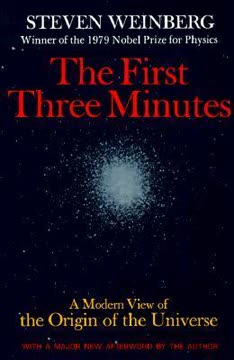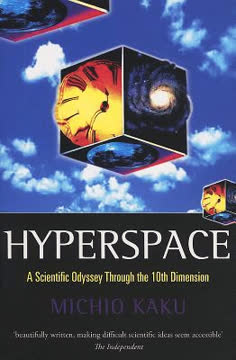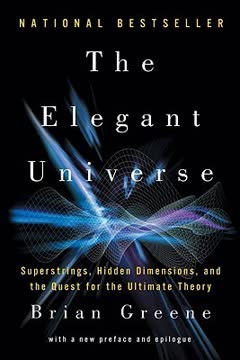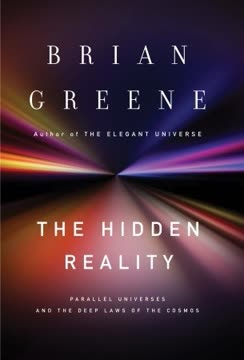Key Takeaways
1. Space and time are intertwined and relative, not absolute
"For we convinced physicists, the distinction between past, present, and future is only an illusion, however persistent."
Spacetime continuum. Einstein's theories of relativity shattered the Newtonian concept of absolute space and time. Instead, space and time are woven together into a four-dimensional fabric called spacetime. This fabric can stretch, warp, and curve in response to the presence of matter and energy.
Relativity of simultaneity. Events that appear simultaneous to one observer may not be simultaneous to another moving at a different velocity. This counterintuitive fact arises because the speed of light is constant for all observers, regardless of their motion. As a result, time can flow at different rates for different observers, leading to phenomena like time dilation and length contraction.
Key implications:
- No universal "now" exists across the universe
- Time is not a fixed backdrop but a dynamic dimension
- Gravity is the curvature of spacetime caused by mass and energy
2. Quantum mechanics reveals a probabilistic and interconnected universe
"Nature does weird things. It lives on the edge. But it is careful to bob and weave from the fatal punch of logical paradox."
Uncertainty principle. At the quantum level, it's impossible to simultaneously know both the precise position and momentum of a particle. This fundamental uncertainty is not due to measurement limitations but is an inherent feature of reality at the smallest scales.
Quantum entanglement. Particles can become "entangled" such that the quantum state of each particle cannot be described independently, even when separated by large distances. This "spooky action at a distance" (as Einstein called it) challenges our classical notions of locality and separability.
Key quantum phenomena:
- Wave-particle duality
- Superposition of states
- Quantum tunneling
- Observer effect
3. The arrow of time stems from the universe's low-entropy beginning
"The future is indeed the direction of increasing entropy. The arrow of time—the fact that things start like this and end like that but never start like that and end like this —began its flight in the highly ordered, low-entropy state of the universe at its inception."
Second law of thermodynamics. This fundamental principle states that the total entropy (disorder) of an isolated system always increases over time. This provides a direction to time's arrow, explaining why we remember the past but not the future.
Cosmic origin of time's arrow. The universe began in an extremely low-entropy state, which allows for the consistent increase in entropy we observe. This initial condition is crucial for understanding the asymmetry between past and future, and remains a deep puzzle in cosmology.
Entropy manifestations:
- Heat flows from hot to cold
- Gases expand to fill available space
- Complex structures tend to break down over time
4. Symmetry underlies the laws of physics and shapes cosmic evolution
"Symmetry underlies the laws of the universe."
Noether's theorem. This profound insight connects symmetries in physics to conservation laws. For example, the symmetry of space under translations leads to the conservation of momentum, while the symmetry of time leads to the conservation of energy.
Symmetry breaking. As the universe cooled after the Big Bang, it underwent a series of phase transitions where fundamental symmetries were broken. These symmetry-breaking events shaped the forces and particles we observe today.
Types of symmetries in physics:
- Translational symmetry
- Rotational symmetry
- Time-reversal symmetry
- Gauge symmetries (internal symmetries of particle physics)
5. The universe is expanding, driven by the stretching of space itself
"Rather than explaining the outward motion of galaxies by a cosmic version of the factory explosion, general relativity says that for billions of years space has been stretching."
Hubble's law. Edwin Hubble discovered that distant galaxies are moving away from us at speeds proportional to their distance. This observation led to the realization that the universe is expanding.
Cosmic expansion. The expansion of the universe is not due to galaxies moving through space, but rather the stretching of space itself. This explains why the expansion appears the same from every vantage point, with no special center.
Evidence for cosmic expansion:
- Redshift of distant galaxies
- Cosmic microwave background radiation
- Abundance of light elements (Big Bang nucleosynthesis)
6. Cosmology relies on symmetry to understand the shape and evolution of space
"By invoking the immense power of symmetry, researchers have been able to narrow the possibilities sharply."
Cosmological principle. This fundamental assumption states that the universe is homogeneous and isotropic on large scales. This symmetry allows cosmologists to apply physical laws to the universe as a whole.
Possible shapes of space. Symmetry considerations limit the possible large-scale geometries of the universe to three options: flat, positively curved (like a sphere), or negatively curved (like a saddle).
Key cosmological observations:
- Uniformity of cosmic microwave background
- Large-scale structure of galaxy distributions
- Cosmic inflation theory (to explain observed flatness and homogeneity)
7. Phase transitions in fields may explain fundamental forces and particles
"Many physicists believe that we are now living in a "condensed" or "frozen" phase of the universe, one that is very different from earlier epochs."
Unified forces. At extremely high energies, such as those present in the early universe, the fundamental forces of nature (electromagnetic, weak nuclear, strong nuclear, and possibly gravity) may have been unified into a single force.
Spontaneous symmetry breaking. As the universe cooled, phase transitions in various fields caused the unified force to split into the distinct forces we observe today. This process is analogous to how water can exist in different phases (steam, liquid, ice) depending on temperature.
Phases of matter/force unification:
- Grand Unified Theory (GUT) scale: Strong and electroweak forces unified
- Electroweak scale: Electromagnetic and weak forces unified
- Current universe: Four distinct fundamental forces
8. The Higgs field gives mass to particles and shapes the universe's structure
"If the ideas in the next section are right, the entire universe is permeated by an ocean of Higgs field—a cold relic of the big bang—that is responsible for many of the properties of the particles that make up you and me and everything else we've ever encountered."
Higgs mechanism. The Higgs field interacts with certain particles, giving them mass. This process is crucial for the formation of atoms and the structure of the universe as we know it.
Vacuum energy. The Higgs field has a nonzero value in empty space, contributing to the vacuum energy of the universe. This concept has important implications for cosmology, potentially explaining cosmic inflation and dark energy.
Consequences of the Higgs field:
- Explains why some particles have mass while others (like photons) do not
- Allows for electroweak symmetry breaking
- May be connected to the cosmological constant and the fate of the universe
Last updated:
FAQ
What's The Fabric of the Cosmos about?
- Exploration of Space and Time: The book delves into the fundamental nature of space and time, examining their roles in the universe and how they have evolved through the contributions of key figures in physics.
- Interconnectedness of Reality: Brian Greene investigates the relationship between space, time, and reality, questioning whether they are real entities or merely useful constructs.
- Cutting-edge Theories: Greene introduces advanced theories such as string theory and M-theory, which propose additional dimensions and challenge our traditional views of the cosmos.
Why should I read The Fabric of the Cosmos?
- Accessible Science: Greene has a talent for making complex scientific concepts understandable and engaging for lay readers, using metaphors and analogies to clarify difficult ideas.
- Intellectual Adventure: The book offers a journey through the history of physics, providing insights into the minds of great scientists and their groundbreaking discoveries.
- Contemporary Relevance: Understanding the nature of space and time is increasingly relevant in today’s scientific discussions, providing a foundation for grasping current debates in theoretical physics.
What are the key takeaways of The Fabric of the Cosmos?
- Nature of Reality: The book emphasizes that our perception of reality is often misleading, shaped by our limited experiences, and that modern physics reveals a universe far stranger than our everyday intuitions suggest.
- Space and Time as Dynamic: Greene illustrates how space and time are not static backdrops but active participants in the universe's evolution, a significant departure from classical physics.
- Quantum Mechanics and Nonlocality: The book discusses the implications of quantum mechanics, particularly entanglement, which challenges traditional notions of separateness in space.
What are the best quotes from The Fabric of the Cosmos and what do they mean?
- "The overarching lesson...": This quote highlights the disconnect between our intuitive understanding of the universe and the complex truths revealed by modern physics.
- "Time and space have framed...": Greene underscores the fundamental importance of these concepts in shaping human thought and scientific inquiry throughout history.
- "The universe is at once surprising...": This reflects the awe and wonder that comes with scientific discovery, emphasizing the unexpected nature of the cosmos.
How does The Fabric of the Cosmos explain the concept of spacetime?
- Unified Framework: Greene presents spacetime as a single entity that combines the three dimensions of space with the dimension of time, crucial for understanding relativity.
- Curvature and Gravity: The book explains how mass and energy warp spacetime, leading to the phenomenon we perceive as gravity, central to Einstein's general theory of relativity.
- Dynamic Nature: Greene emphasizes that spacetime is not a static backdrop but is influenced by the presence of matter and energy, shaping its structure and behavior.
What is the significance of the spinning bucket experiment in The Fabric of the Cosmos?
- Challenge to Absolute Space: The spinning bucket experiment illustrates the debate between Newton's concept of absolute space and Mach's relational perspective.
- Introduction of Spacetime: Greene argues that even in an empty universe, the spinning bucket can be understood through the lens of spacetime, shifting the discussion from absolute to relative concepts.
- Connection to General Relativity: The experiment serves as a precursor to understanding how general relativity redefines our notions of space and time, emphasizing their interdependence and dynamic nature.
How does The Fabric of the Cosmos address the flow of time?
- Illusion of Flow: Greene argues that the intuitive sense of time flowing is an illusion, as all moments in time exist simultaneously in the spacetime loaf.
- Frozen Moments: The book suggests that each moment is like a still frame in a film, existing independently of our perception, encouraging readers to rethink their understanding of past, present, and future.
- Relativity's Impact: Greene explains how relativity complicates our understanding of time, showing that different observers can have different experiences of time based on their relative motion.
What does The Fabric of the Cosmos say about the arrow of time?
- Directionality of Events: Greene discusses how certain processes in nature, such as entropy, give time its arrow, leading to a distinction between past and future.
- Cosmological Origins: The book explores the idea that the arrow of time may be linked to the conditions present at the universe's inception, particularly during the Big Bang.
- Philosophical Implications: Greene invites readers to consider the philosophical ramifications of time's arrow, including how it shapes our understanding of causality and the unfolding of events.
How does The Fabric of the Cosmos relate to quantum mechanics?
- Quantum Uncertainty: Greene explains that quantum mechanics introduces a fundamental level of uncertainty into our understanding of reality, challenging classical notions of determinism.
- Entanglement: The book discusses the phenomenon of quantum entanglement, where particles can be interconnected regardless of distance, defying traditional ideas of separateness.
- Measurement Problem: Greene addresses the measurement problem in quantum mechanics, highlighting how the act of measurement influences the properties of particles.
What are the implications of nonlocality discussed in The Fabric of the Cosmos?
- Challenge to Locality: Greene explains that nonlocality suggests that particles can be connected in ways that transcend traditional spatial separations.
- Quantum Connections: The book illustrates how quantum mechanics allows for instantaneous correlations between distant particles, leading to a reevaluation of our understanding of space.
- Philosophical Considerations: Greene encourages readers to reflect on the philosophical implications of nonlocality, including how it affects our understanding of causality and interconnectedness.
What is inflationary cosmology as discussed in The Fabric of the Cosmos?
- Rapid Expansion of Space: Inflationary cosmology posits that the universe underwent a rapid expansion shortly after the Big Bang, explaining the uniformity of the cosmic microwave background radiation.
- Solving Cosmological Problems: This theory addresses key issues such as the horizon problem and the flatness problem, providing a framework for understanding the universe's large-scale structure.
- Quantum Fluctuations: Greene explains that quantum fluctuations during inflation could lead to the formation of galaxies and other structures, linking quantum mechanics with cosmological evolution.
What is the significance of dark matter and dark energy in The Fabric of the Cosmos?
- Composition of the Universe: Greene discusses how dark matter constitutes about 25% and dark energy about 70% of the universe, with ordinary matter making up only about 5%.
- Unresolved Mysteries: The identities of dark matter and dark energy remain major mysteries in cosmology, with various candidates proposed but none confirmed.
- Impact on Cosmic Evolution: Dark energy, in particular, is linked to the accelerated expansion of the universe, fundamentally affecting its future trajectory.
Review Summary
The Fabric of the Cosmos is praised for its accessible explanations of complex physics concepts, engaging writing style, and use of metaphors. Readers appreciate Greene's ability to convey difficult ideas without oversimplifying. Many find the book enlightening and mind-expanding, though some struggle with the more advanced topics. The book covers a wide range of subjects, from classical physics to quantum mechanics and string theory. While some readers find certain sections challenging, most recommend it as an excellent introduction to modern cosmology and theoretical physics.
Similar Books










Download PDF
Download EPUB
.epub digital book format is ideal for reading ebooks on phones, tablets, and e-readers.







